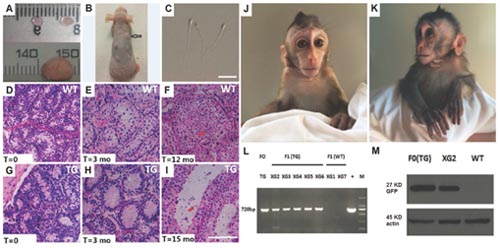Time:2015-09-17
Non-human primates (NHP) are very important animal models for neuroscience research. Recently, breakthroughs in gene editing methods have made site-specific gene-modified NHP possible. However, the long reproduction cycle (at least 4.5 years) is a significant obstacle for a widespread use of gene-modified NHP animal models.
In a recent study, researchers at the Institute of Neuroscience, Chinese Academy of Sciences, successfully accelerated the sexual maturity of juvenile cynomolgus monkeys by testicular xenografting. Testicular tissues were obtained from one 14-month wild-type (WT) and one 27-month HA-hMeCP2-2a-GFP transgenic(Tg) monkey, and implanted subcutaneously in adult castrated nude mice. Sperm maturation occurred within the mouse hosts over approximately 10 months. Six live (2 WT, 4 Tg) offsprings were born by using sperm derived from testicular xenografts.
These results demonstrated that testicular xenografting could markedly shorten the reproduction cycle required for sexual maturity and pregnancy in cynomolgus monkeys. Thus, testis xenografting may facilitate the development of genetically modified NHP models. Another important implication of this work is the potential of restoring fertility in young cancer patients undergoing radiotherapy and/or chemotherapy.
The paper entitled “Generation of macaques with sperm derived from juvenile monkey testicular xenografts” was published online in the Cell Research. LIU Zhen is the first author and Dr. SUN Qiang is the corresponding author.
This work was supported by grants from the Ministry of Science and Technology of China, the Chinese Academy of Sciences, the National Key Technology R&D Program of China and the Shanghai City Committee of Science and Technology.

(A-C) Generation of motile monkey sperms by using testicular xenografting.
(D-I) Sample sections of xenografts from the WT and TG monkey testicular tissues at different times (marked as T).
(J, K) Monkeys obtained by using sperm from the xenograft of the WT and TG monkey donors.
(L, M) PCR and western blotting analysis showing the presence of GFP in 5 TG F1 monkeys.
 附件下载:
附件下载: